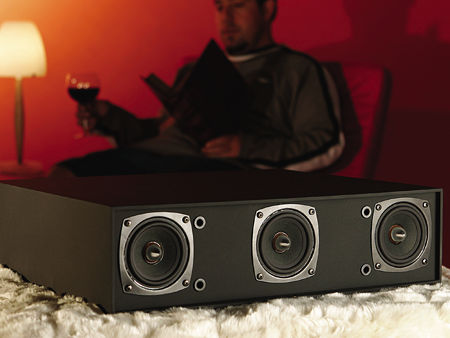ZVOX 315 Sound Console Amplified Audio System
There are many different approaches to home theater, which is one of the reasons why this magazine is as burly as it is, month after month. The stereo speakers built into many modern televisions are nirvana for some, while carefully matched loudspeakers, preamplifiers, processors, and amps are the only solution that others would ever consider. Somewhere between those two polar extremes are the ubiquitous home-theater-in-a-box systems and novel products like the ZVOX 315 Sound Console. The idea here is simple, and noble, offering your TV a painless upgrade to the inadequate audio it was born with.

Getting Everything Set Up
The 315 Sound Console doesn't include an owner's manual per se, just a single sheet of paper to guide the user through the physical setup and configuration. The best match for the 315 is a TV with "variable audio" outputs. You'll want to work your onscreen menus to turn the TV speakers off and turn the variable audio on so that your TV remote can control the master volume through the Sound Console. If this isn't an option, you can also connect the 315 to the headphone jack. Cables for both RCA-type analog stereo and stereo minijack hookup are included. If you don't have a headphone jack, you can connect the 315 to your cable box's variable out, which, unless your cable box is one of the few that has line-level audio inputs, will make it a cable-TV-only solution. Then again, you could connect the 315 directly to a source component such as a DVD player, but you'll need to set the volume via the Sound Console's rear-panel knob. In general, the rear-panel location of all the controls is a good idea, keeping them out of sight, as you will most likely not need to revisit them. If you are indeed going with variable output, then this setup will likely be a one-time procedure. In my case, it took me less than two minutes to hook up the Sound Console and switch off my TV speakers. A smart circuit knows when the first of the two minijacks is receiving a signal and sets the other jack as a second input. If a low-frequency-phile plugs an outboard subwoofer into minijack number two instead, the circuit automatically converts it to an output.
The unobtrusive, décor-friendly, component-sized cabinet houses an array of three separate loudspeakers across the front, in addition to a bandpass subwoofer that opens to the rear. Although the 315's positioning requirements are not slavish—the results can be remarkably good when you place the unit behind the TV, for example—the most natural location would be directly above or below the screen, as with a center-channel speaker. The proprietary PhaseCue circuitry inside sets the Sound Console apart. PhaseCue is a soundstage-widening technology, and it works like this: The left speaker plays the standard left channel of your movie or music, plus out-of-phase information from the right channel (L–R, or left "minus" right) generated by the PhaseCue circuitry. You can control the amount of out-of-phase information, the extent of that effect, via the PhaseCue knob on the unit's rear panel: lower for a more-natural result or more processing for wider dispersion and, when combined with the generous bass, a greater illusion of surround. The right speaker logically combines the right signal with the R–L info, while the mono center speaker receives a balanced L+R signal. The subwoofer also receives the L+R information, at a preset crossover of 175 hertz. Twenty of the system's claimed 40 watts are dedicated to the left and right channels, distributed to the three individual speakers according to the PhaseCue settings. When you turn PhaseCue all the way down, the left and right channels receive no signal, and only the mono L+R center is active.
Trying Everything Out
With neither the television's nor the 315's volume turned up especially high, the Sound Console provided volume to spare and plenty of bass on all of my DVD demos. Explosions were deliciously juicy, with enough boom to give the entire room a little shake. I did hear some clipping on high frequencies, though, even at moderate sound levels. While I never perceived that any sounds originated behind me, the soundstage's enhanced width, further sold by the ample low (but far from subterranean) frequencies, did convince me that objects were sometimes moving past, front to back. Dialogue was generally clear, with cleanly delivered details from the DVD player's two-channel Dolby mix-down.
Music playback was passable, with some of the nuances similar to those I heard from movies. While the PhaseCue effect added an interesting resonance to instruments, it also created an outright echo on vocals and needed to be adjusted. The overall sound would definitely benefit from more available headroom, as well. Of course, in a typical configuration, you'll need to have the TV turned on to pass the CD music signal from your DVD player, even though no video is present.
By design, the three speakers and sub provide an experience that virtually no onboard TV audio can match. For the setup to be any less complicated, the Sound Console would have to plug itself in. I would rate the experience as excellent for normal TV watching, quite good for DVDs (with the headroom caveat), and fine for music, although you might want to run a CD or MP3 player directly into the secondary input, bypassing the TV. I'm hard pressed to think of a better single-box audio solution. Hopefully, the few seconds you spend reading the instructions and the many hours enjoying the improvement might instill a curiosity that leads you to a more-elaborate home theater system, someday.
Highlights
• Easy to buy, easy to install, and easy to configure
• A fast "stepping stone" solution to go beyond standard TV audio
- Log in or register to post comments



























































